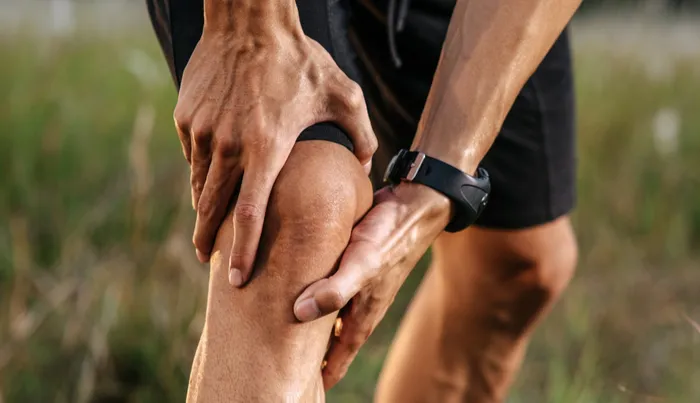Managing osteoarthritis with Ayurveda: effective, evidence-based alternatives to painkillers
Management

In Ayurveda, osteoarthritis is also referred to as "Sandhigata Vata", a condition characterised by vitiation of Vata dosha affecting the joints. Vata, when imbalanced, leads to dryness, cracking, degeneration, and pain.
Image: Freepik
Osteoarthritis (OA) is a common degenerative joint disorder characterised by the deterioration of cartilage, leading to pain, stiffness, and reduced joint function. It primarily affects the weight-bearing joints of the body, such as the knees, hips, hands, and spine.
OA is mostly found in people over the age of 40, and as the incidence of it continues to rise, it stirs up interest in natural treatment modalities. Ayurvedic medicine offers promising strategies for managing osteoarthritis through natural remedies, lifestyle modifications, and personalised therapies. This column explores the clinical findings related to OA, Ayurvedic perspectives, and integrated treatment protocols.
Signs and symptoms:
-Sharp aching pain
- Burning sensation in the muscles and tendons
- Joint pain often after movement
- Tenderness of joints upon pressure
- Inability to perform daily activities
- Reduced range of motion
- Stiffness upon waking in the mornings
- Crepitus
- Radiological signs may indicate: Joint space narrowing, osteophyte formation, subchondral sclerosis, and cysts, confirmed via X-ray imaging.
Patho physiologically, OA involves cartilage degeneration, subchondral bone remodelling, synovial inflammation, and periarticular muscle weakness. These changes contribute to the chronic pain and disability observed in patients.
In Ayurveda, osteoarthritis is also referred to as "Sandhigata Vata", a condition characterised by vitiation of Vata dosha affecting the joints. Vata, when imbalanced, leads to dryness, cracking, degeneration, and pain.
Sandhivata is also often associated with aging, poor digestion (Mandagni), and tissue depletion (Dhatu Kshaya), especially of Asthi Dhatu (bone tissue) and Shleshaka Kapha (lubricating synovial fluid).
Ayurvedic treatment principles
The management of osteoarthritis in Ayurveda focuses on:
- Balancing Vata dosha
- Strengthening bone and cartilage tissues
- Improving digestion and metabolism
- Detoxifying the body
- Reducing inflammation and pain
- Rejuvenating the tissues
- Maintaining overall health
Ayurvedic management involves dietary modifications, herbal medicines, Panchakarma procedures, and lifestyle adjustments tailored to individual constitution (Prakriti).
Research-Backed Ayurvedic treatments for osteoarthritis
- Snehana (Oleation): Internal (ghee consumption) and external (oil massage) oleation softens tissues and reduces Vata.
- Swedana (Sudation): Herbal steam therapy helps relieve stiffness and improve circulation.
- Basti (Medicated Enema): The most effective treatment for Vata disorders, with the use of medicated oils like Dhanwantaram Taila or Balashwagandhadi Taila directly nourishes joints and reduces degeneration. A clinical study published in the World Journal of Pharmaceutical and Medical Research demonstrated that enema therapy relieved all symptoms of osteoarthritis of the knee joint with no recurrence.
- Virechena (Purgation): Helps eliminate toxins often associated with Pitta dosha. Abhyanga (Oil Massage) - Using warm herbal oils to lubricate joints and improve circulation.
Diet and lifestyle
- A diet centered around pacifying vata is important. Consume more warm, moist, oily, and easily digestible foods such as soups, ghee, sesame oil, and cooked vegetables.
- Avoiding dry, cold, processed, and fermented foods.
- Practice of Abhyanga (oil massage) daily. Gentle yoga postures improve flexibility and strengthen periarticular muscles, and regular physical activity.
- Maintaining a consistent Ayurvedic daily routine is recommended.
Rasayana (rejuvenation therapy)
Formulas like Laksha Guggulu, Trayodashanga Guggulu, and Shatavari promote the regeneration of bones and joints. Herbo mineral ayurvedic medicines such as Suvarna Bhasma, when used judiciously under supervision, support deep tissue rejuvenation.
Modern clinical insights into Ayurvedic interventions
Recent clinical reviews support the efficacy of Ayurvedic approaches:
- Another study found Ayurvedic interventions, including herbal formulations and Panchakarma, were significantly effective in reducing pain and improving function in knee osteoarthritis, with minimal side effects.
- A study concluded that Ayurvedic treatments provided longer-lasting relief compared to conventional treatment, especially with the use of gold preparations that assist in healing.
Osteoarthritis requires more than just symptomatic management; it demands a systemic, holistic approach. Ayurvedic medicine offers time-tested, personalised therapies rooted in nature, supported increasingly by scientific research.
From natural anti-inflammatories to Panchakarma treatments, Ayurveda not only alleviates joint pain but also rejuvenates the body's ability to heal itself.
For those seeking sustainable solutions, Ayurveda provides a promising path toward joint health and vitality.

Dr Tamlyn Govender
Image: File
Dr Tamlyn Govender is registered with theAllied Health Professions Council of South Africa to practise Ayurveda. Her Ayurvedic practice is in Pretoria East. Visit www.ayuhealthandwellness.com, or [email protected]. To learn more or to get more health tips, follow her on Instagram, Facebook, and YouTube @ayuhealthandwellness. To book a consultation, WhatsApp on 081 342 3890.
* Please consult a healthcare professional before taking any of these recommendations.
Related Topics: